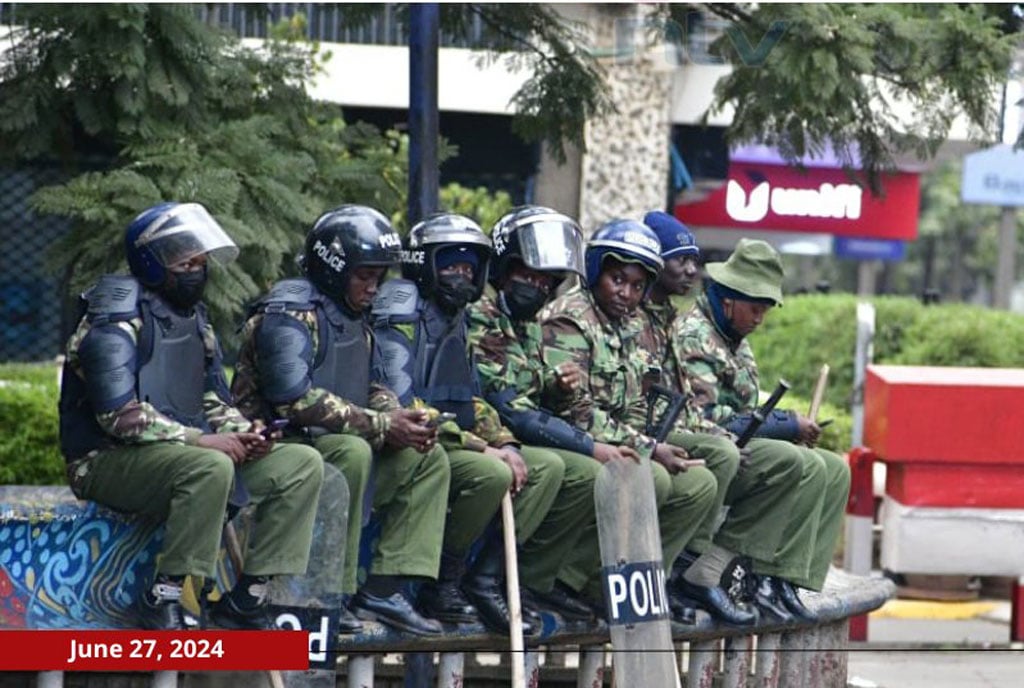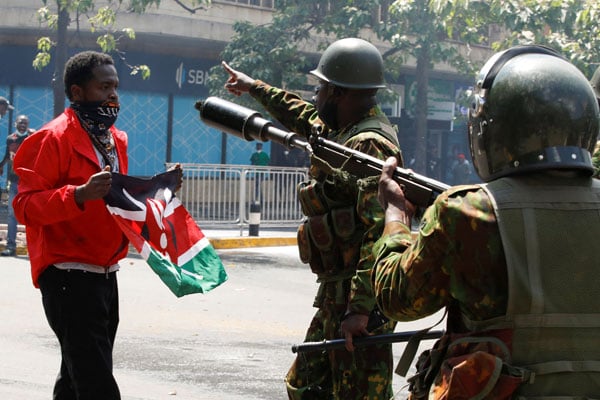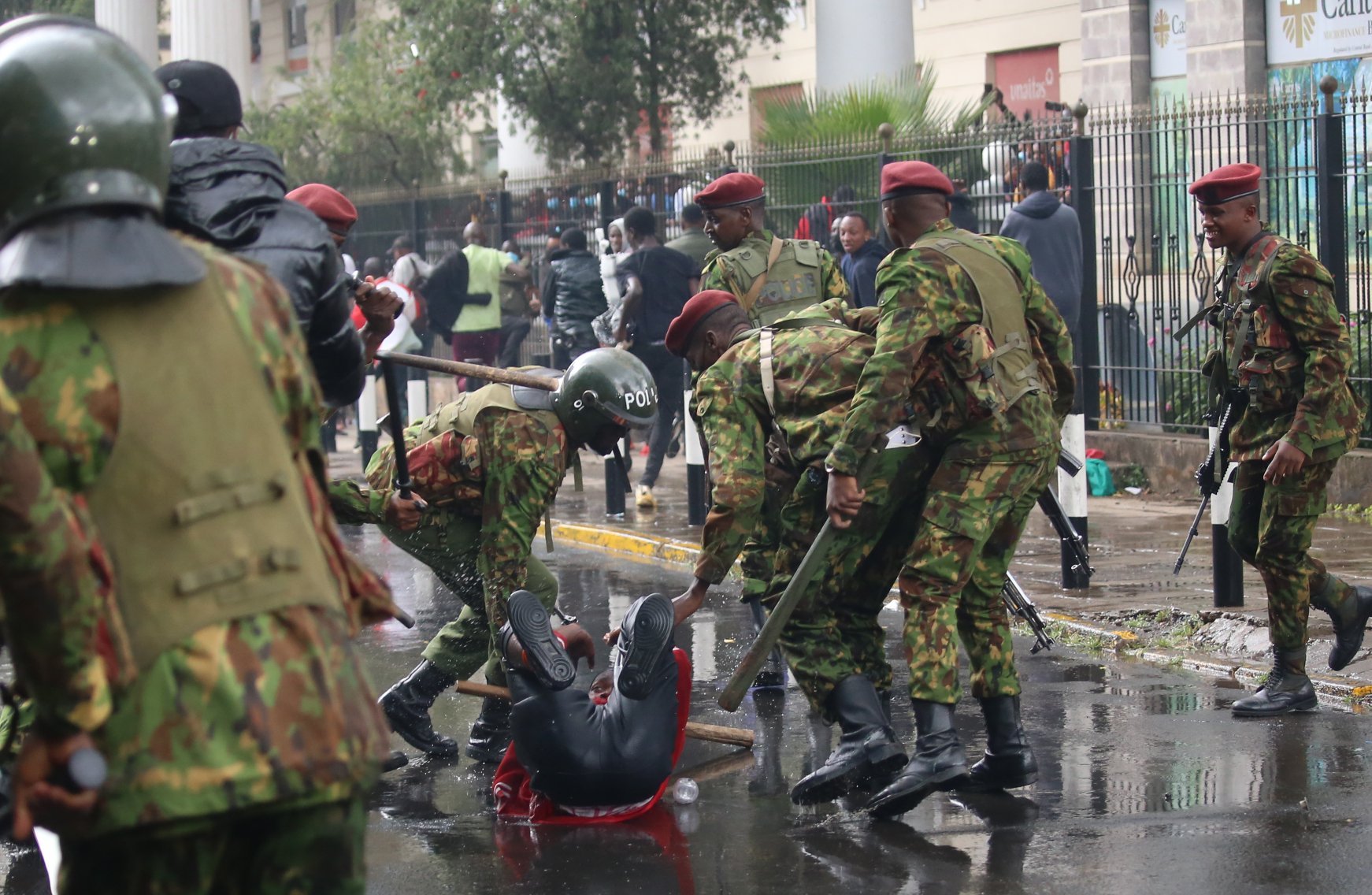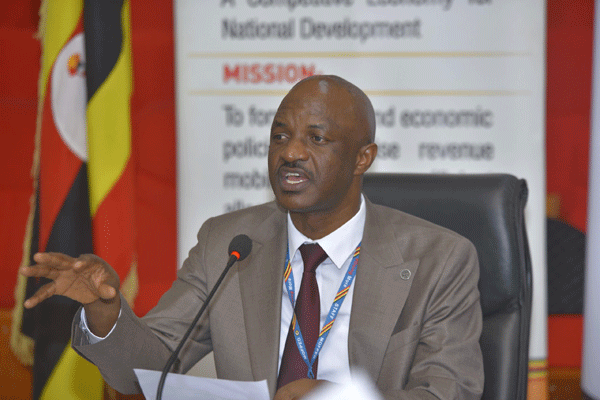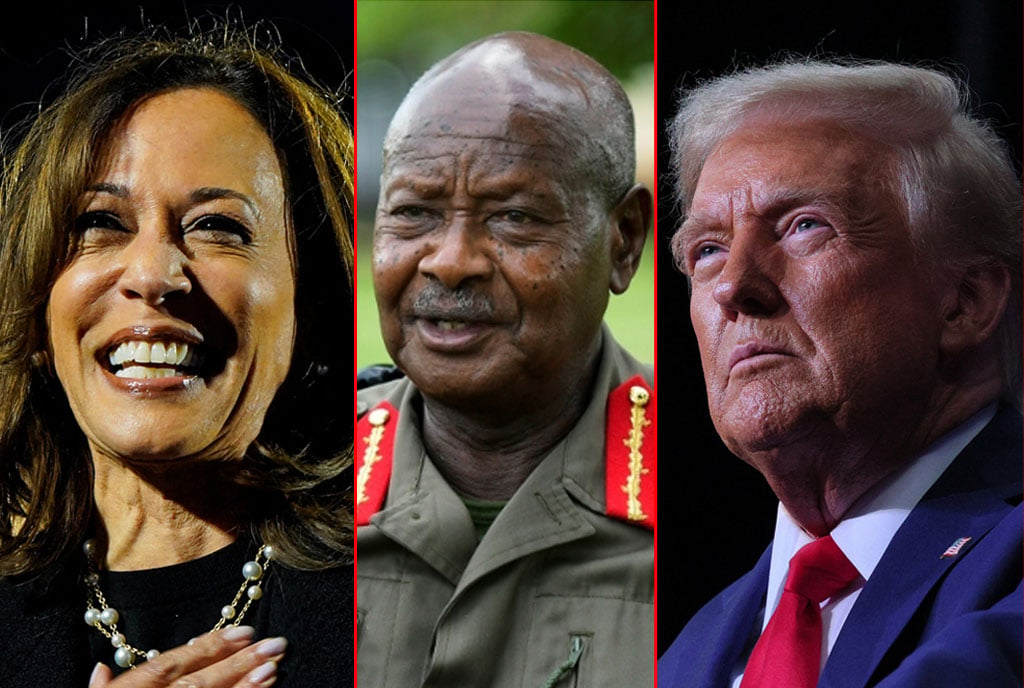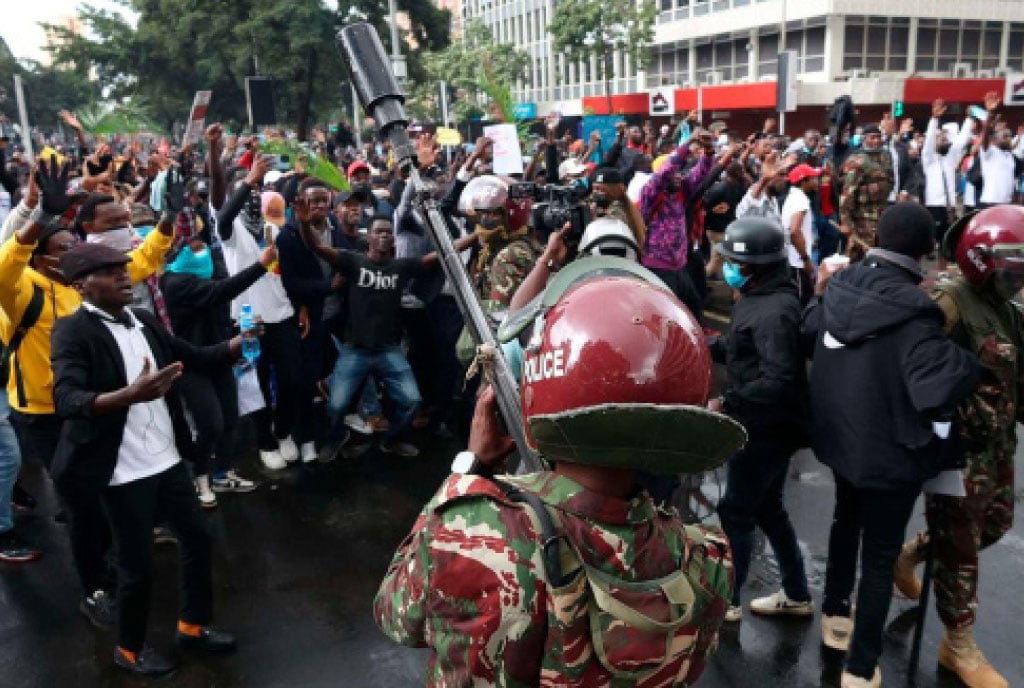
Youth confront police officers during protests against the Finance Bill 2024 in Nairobi, Kenya, on June 20. PHOTO/FILE
Plumes of black smoke circle the grey skies of Nairobi’s Central Business District depicting the rancour amongst protesters due to the prevailing cross-currents in East Africa’s largest economy.
The wave of protests commenced last week after the introduction of the Finance Bill, which, among others made radical tax hikes on items such as bread, diapers, and cooking oil to generate $2.7 billion to pay off soaring debt and interest owed to Chinese banks and the Eurobond.
This Bill, which was approved by the House plenary on Tuesday, collided with a groundswell of resentment among youngsters, who accuse the government of inflating budgets to sustain the political patronage gravy train and sustain the Executive arm of government’s profligacy.
President William Ruto on Wednesday withdrew the Bill, a day after he accused the protesters of treason. Twenty-three persons were killed and 30 others were being treated for bullet wounds, according to Kenya’s Medical Association; and several buildings, including Parliament, were torched.
How did tech-savvy youth re-invent the culture of protests by liberating themselves from the shackles of tribal barons and being able to galvanise legions across the country including the president’s backyard in Eldoret? Could these protests offer new insights into the kaleidoscope of African social movements, which includes trade unions, burial societies, students, religious and gender movements?
Betrayed
A volume edited by Professors, Mahmood Mamdani, and Ernest Wamba dia Wamba on African Studies in Social Movements and Democracy which was first published by CODESRIA in 1995, suggests that African social movements including the bread riots in Tunisia, the communist movement in Sudan, the ‘Kaduna Mafia’ in Nigeria and the burial societies in Zimbabwe are bound by the common thread, which is the “experience of past oppression and the constant struggle for an identity that will encompass survival.”
In the current protests, the youngsters in Kenya have galvanised around bread and butter issues, including the rising costs of living and high taxes, and an economy which is tethered to multi-national corporation interests.
In a country whose median age is 19 years, this angst over the soaring cost of living and the Finance Bill has largely taken place on cyberspace platforms like TikTok and the microblogging platform X, where Generation Z and millennials have authored tweets and shared videos, photos, memes, and live streams.
Many youngsters supported the Kenya Kwanza movement in the 2022 presidential election whose campaign slogan centred on uplifting millions of Kenyan lives from abject poverty and ending the dominance of dynasty politics—the Finance Bill was the highest act of betrayal.
The protesters have sharply contrasted Mr Ruto’s message by turning the microscope on his 18-gold karat Bvlgari designer watch valued at Shs250m and his gold buckle crocodile skin belt valued at Shs12m.
On Saturday, a Space organised by protesters on X recorded one of the highest audiences with 60,000 live listeners and 1.2 million total views during a seven-hour stretch. The micro-blogging site has become a potent weapon in the crucible of protest politics, replacing the antiquated bonfire, a place in African oral tradition where young warriors and elders sat at the feet of wisdom.
It is in this space that further plans of the revolution were hypothesised as well as coordinating to free their colleagues who had been abducted by security personnel and detained incommunicado. The bonfire lit the fuse for the first primary resistance against imperialists across Africa.
Phases of ‘bread riots’
T.O. Ranger, a former history professor at the University of Dar es Salaam, who is the author of Connexions between Primary Resistance, Movements and Modern Mass Nationalism in East and Central Africa, has posited that the anti-colonial struggles went through three phases. The first phase, which Ranger named ‘Primary Resistance’ , was what the natives saw as foreign intrusion into their societies. Among the resisters in Uganda were Omukama Kabalega, the King of Bunyoro Kitara Kingdom—who relied on rudimentary weapons to fight the coloniser and the Nyabingi cult in south-western Uganda, which venerated or worshipped the deity of the woman known as Nyabingi in Rwanda, around 1800. Later on, the Nyabingi deity is said to have possessed Queen Muhumuza, who rebelled when her son was denied the throne in Rwanda. She reportedly fled to Uganda where she resisted the British in Kigezi and Mpororo until her capture and death in Mengo, near Uganda’s capital in 1945.
The Nyabingi cult evolved and became part of the transnational, black-militant ideology and cultural discourse in Jamaica against imperialism.
The Guusi uprising in western Kenya is instructive to the debate on social movements as part of the primary resisters. It was a pan-tribal pagan sect, creating its society of true believers, whom it bound by its codes of conduct and promised eventual triumph and reward. Rangers argues that the colonial period, in its mythology, was merely a testing period devised by the God of Africa to sort out the true believers from the faint-hearted; before long those who remained true would enter into the wealth and power of the Whites.
The Gusii’s most-venerated warriors and prophets, noted for their militant anti-British stance, were claimed by the movement. Zakawa, the great prophet, Bogonko, the mighty chief, and Maraa, the Laibon responsible for the 1908 rebellion, became its symbols, infusing into the living the courage and strength of past heroes. Leaders bolstered their legitimacy by claiming to be the mouthpiece of these deceased prophets.
The third phase of the anti-colonial struggles was “mass nationalism.” Rangers says some, at least of the intermediary opposition movements of a millenarian character, which are usually by common consent given a place in the history of the emergence of nationalism, were closely linked and essentially similar to some movements of primary resistance. Rangers argues that where nationalist movements do succeed in achieving mass emotional commitment, they will often do it partly by the application of the same methods of earlier movements. He argues that where nationalist movements are faced with strong settler regimes, as in southern Africa, they will tend to move towards a strategy of violence, which is seen by them as springing out of the traditions of “primary resistance.”
Fourth phase?
Today, African social protest movements are largely hybrid—infusing financial support and activism tactics from the West and oral traditional methods like the red-beret revolution of National Unity Platform president Robert Kyagulanyi, alias Bobi Wine.
President William Ruto is a protégé of Daniel Arap Moi, Kenya’s former head of State, who was among the third phase of resistors against British imperialism.
The latest bread protests may not only present Kenya’s exceptionalism to the rest of Africa. They could have reinforced a new chapter—the fourth phase of social movement struggles in the seminal works of resistance and modern mass nationalism in Africa led by youngsters who are challenging the African nationalist movement status-quo and the political elite who have exploited ethnic cleavages to rule.
The winds of change of this fourth phase movement, which already swept across North Africa, including Tunisia, Egypt, and Libya during the Arab Spring, could be menacingly moving towards the South.
Sabelo J Ndlovu-Gatsheni, a Professor and chairperson of Epistemologies of the Global South at the University of Bayreuth, Germany, in his book titled, Beyond Coloniality of Internationalism, offers a perspective where he postulates that “like all others hegemonic systems, global coloniality has always been contested, resisted and even forced not only to retreat and reconsider some technologies of subjection but to also make concessions and reforms of the system of domination.”
During the fourth phase of social movement resistance, the Kenyan bread protesters believe their leaders have replaced the colonisers.
During his televised address to the nation on June 26, Mr Ruto’s raspy voice cracked—betraying the hawkish stance he had adopted on Tuesday when he accused some of the rogue protesters of committing treason. “Listening keenly to the people of Kenya who have said loudly that they have nothing to do with this Finance Bill I concede and, therefore, I will not sign the Finance Bill, 2024 and it shall subsequently be withdrawn.”
The Kenyan bread protests are unorthodox and appear faceless without a prominent political leader. However, it is this novelty in protests that has made scores of its leaders ubiquitous and difficult to identify. The young bread protesters remain committed to the ethos of African social movements determined to end a rapacious system of domination by forging their own identity and the gut instinct to survive in harsh conditions. They have relied on social media platforms to rebuke politicians through satirical cartoons, parodies, and poetry, deeply embedded in the citizen’s mental psyche.
Mr Ruto made a triumphant return from the United States last month after cementing a deal to become one of Africa’s greatest allies of the West underpinned by a Nato alliance deal and the decision to send Kenyan police to Haiti for a UN peacekeeping mission. Whereas Ruto’s geo-political and geo-strategic posture could cement an enduring legacy with the West, it has not exorcised the apparitions on the domestic front.
Why Kenyan Government Scrapped Bread Tax
On June 18, Kenya’s government scrapped some proposed taxes in this year’s controversial Finance Bill, including a 16 percent levy on bread, after a public outcry.
The announcement by legislators came as police fired tear gas and used water cannon to try to disperse angry protesters in the capital, Nairobi.
Dozens of people had been arrested, and lawyers had earlier joined chanting crowds at the city’s main police station to demand that detainees be freed.
Since coming to office in 2022, President William Ruto has introduced several new and unpopular taxes with the aim of eliminating the country’s national debt of nearly $80b.
But critics of the latest proposals feared they would stifle economic growth and lead to job losses.
Some of the protesters marching through the capital called on the president to resign, shouting, “Ruto must go! Ruto must go!”
The U-turn over the new Finance Bill was announced by Mr Kuria Kimani, the chairman of the parliamentary Finance Committee, at a press briefing attended by President Ruto and other lawmakers in the ruling coalition.
His finance team had been collecting public views on the Bill and he said the decision to drop some of the proposals had been made to protect Kenyans from the increasing cost of living.
Generation Z protested over other proposed taxes in the Bill such as sanitary towels. But MPs passed it on Tuesday, amid the protests.
On Wednesday, Mr Ruto declined to assent to the Bill, and said it would be withdrawn.
Source: BBC

